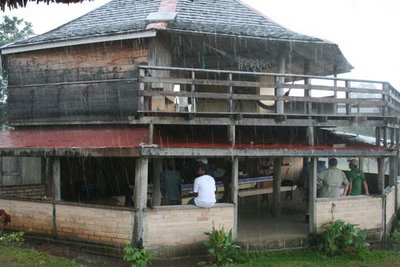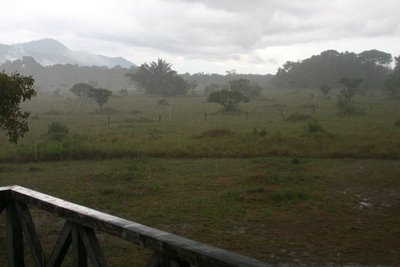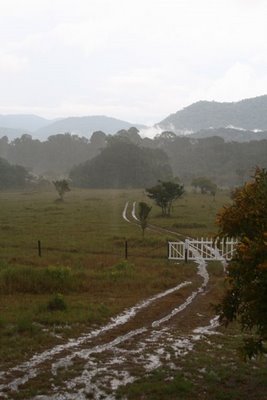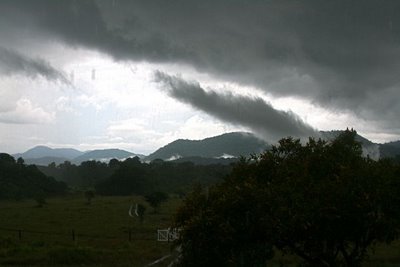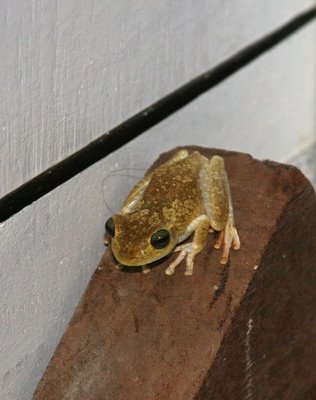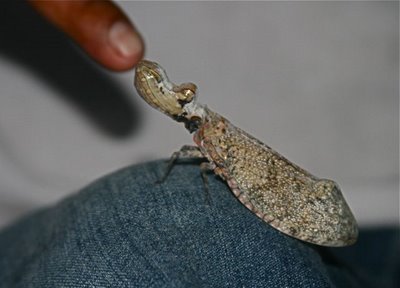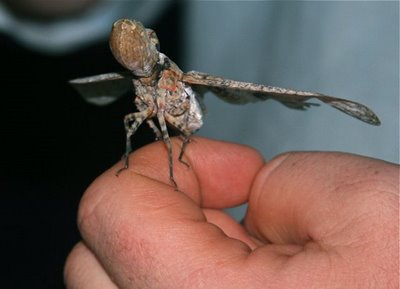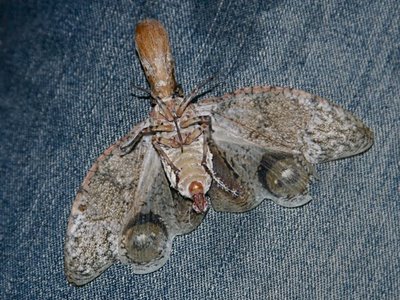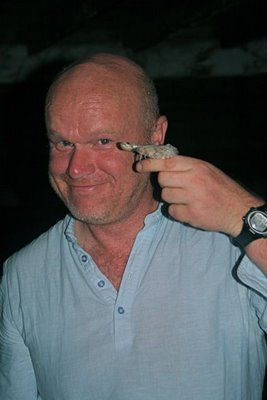Seeing the Harpy Eagle
It took quite a bit of maneuvering for our skilled guides, Ron Allicock and Luke Johnson, to spot the fledgling harpy eagle perched on a branch of the ceiba, then get us into a position where we could see it, too. But it was there, it was there, and our hearts overfilled with joy at the prospect of seeing even a bit of it.
We practically bent double to get the scopes on the bird, more than a hundred feet overhead in the very top of the emergent ceiba tree.
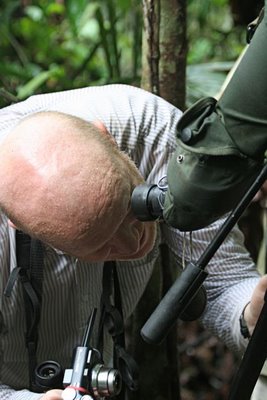 Mike Weedon gets an eyeful. Unnh!
Mike Weedon gets an eyeful. Unnh!For the next forty minutes, we admired this from our contorted positions:
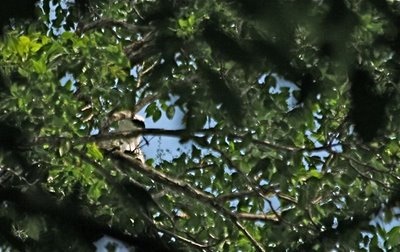
just the face of a young harpy. It was enough. It was wonderful. Every now and then the breeze would blow its feathers and raise its double crest and we'd sigh in admiration. We were looking at a harpy eagle, the most important bit of a harpy eagle, and a baby harpy at that.
Here's Ron Allicock, who found it for us in the first place. Obviously, the nest was a stakeout; it was a known nest, discovered when logging crews came to fell some trees in a selective cut. (The ceiba will not be cut, and the harpies are doing fine). But it takes some serious doing to see the eaglet even when you find the nest, because at the time we visited, it was trying its wings and "branching" all over the enormous tree, sometimes in view and mostly not, obscured by the canopy below the emergent tree. In fact, the second group of our tour who visited the nest the next morning missed seeing the eaglet. Let's have a moment of silence for those hopeful birders. No gloating here.
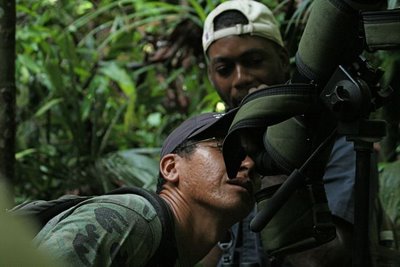
But Luke wanted more for us, so he and another expert guide set quietly off through the jungle to try to find a better vantage point.
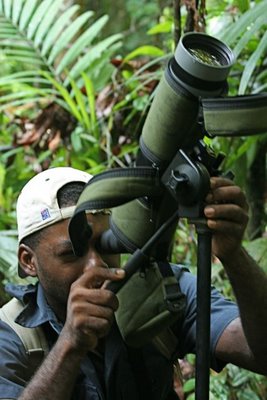
And find it they did.
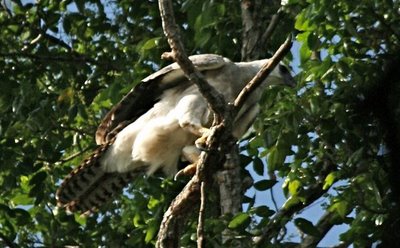
O.M.G. Now we had not just the head, but the whole enchilada, fluffy harpy eaglet bloomers, massive talons and all. Whooooooo.
The eaglet noticed.
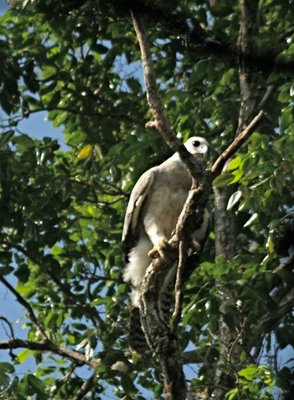
But it preened and seemed fairly unconcerned about these primates far below which were after all too large to practice upon.
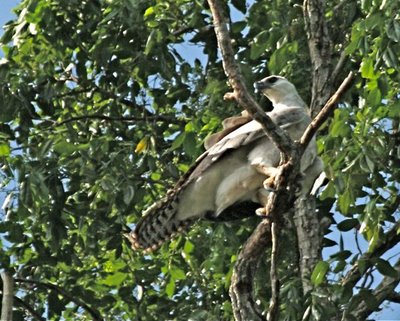
Harpy eaglets apparently come one to a nest. Though two eggs are laid, the second is abandoned as soon as the first hatches, and all the parents' focus goes to raising the sole princeling or princess. A harpy eaglet stays in the vicinity of the nest and in the care of its parents for a year or more, waiting for the occasional sloth/monkey to be airflighted in, and growing stronger until it's ready to try its six-foot wings and catch its own prey. With a reproductive rate like that, it's no wonder this apex predator is so rare.
Luke watches Erica get her camera lined up to digiscope the eaglet.
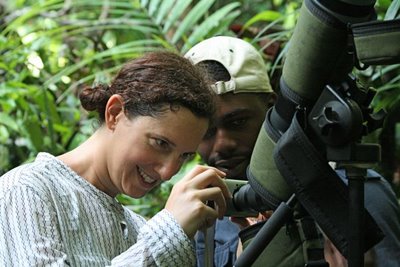
And the eaglet looks right back.
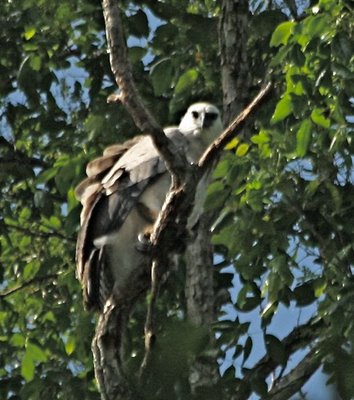 We quietly withdrew, grateful for this audience with a mythic bird.
We quietly withdrew, grateful for this audience with a mythic bird.Keep growing and thriving, prince or princess, whichever you be. Thank you, Surama Eco-Lodge, thank you Ron Allicock and Luke Johnson, US AID and the Guyana Sustainable Tourism Initiative, for taking us to the nest of the great forest harpy. I am grateful to be able to share the experience with so many people, and hopeful that one harpy eagle is ultimately worth more to the people of the area than many, many fallen logs.
Go see. Give Guyana, its giant otters, its potoos and giant anteaters and harpy eagles some of your travel budget if you can. It will not disappoint.
Back here on earth, I will be speaking and showing my paintings at the Riverside Artists' Cooperative Gallery, 188 Front Street, Marietta, Ohio 45750 at 6 pm on Friday, March 13. For more information please call (740) 376-0797. And don't forget to blurt "BLOG" when you introduce yourself!
Labels: birding in Guyana, Guyana South America, harpy eagle nest, harpy eaglet, Surama Eco-lodge

